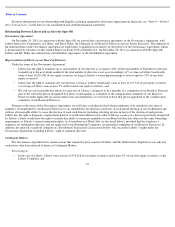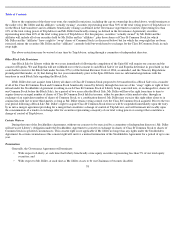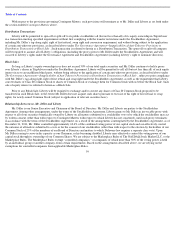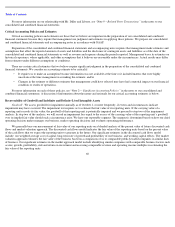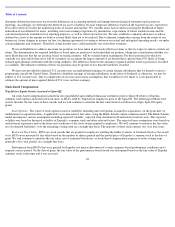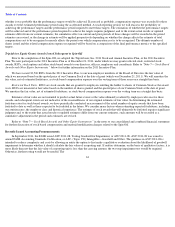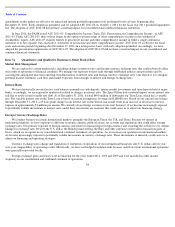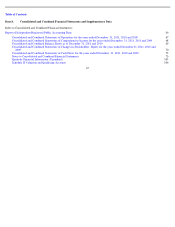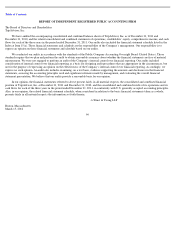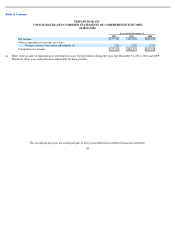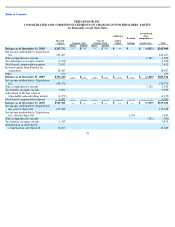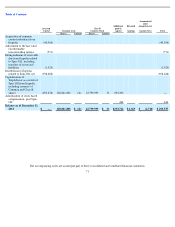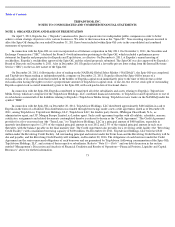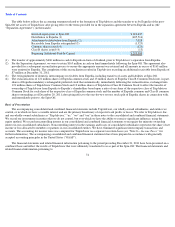TripAdvisor 2011 Annual Report Download - page 68
Download and view the complete annual report
Please find page 68 of the 2011 TripAdvisor annual report below. You can navigate through the pages in the report by either clicking on the pages listed below, or by using the keyword search tool below to find specific information within the annual report.
Table of Contents
amendments in this update are effective for annual and interim goodwill impairment tests performed for fiscal years beginning after
December 15, 2011. Early adoption is permitted, and we adopted ASU 2011-
08 on October 1, 2011 for the fiscal year 2011 goodwill impairment
test. The adoption of ASU 2011-08 did not have a material impact our consolidated and combined financial statements.
In June 2011, the FASB issued ASU 2011-05, Comprehensive Income (Topic 220): Presentation on Comprehensive Income , or ASU
2011-05. Under ASU 2011-05, there will no longer be the option to present items of other comprehensive income in the statement of
stockholders’ equity. ASU 2011-05 requires entities to present net income and other comprehensive income in either a single continuous
statement or in two separate, but consecutive, statements of net income and other comprehensive income. ASU 2011-05 is effective for fiscal
years and interim periods beginning after December 15, 2011 on a retrospective basis, with early adoption permitted. Accordingly, we have
adopted the presentation requirements of ASU 2011-05. The adoption of ASU 2011-05 did not have a material impact on our consolidated and
combined financial statements.
Market Risk Management
We are exposed to certain market risks, including changes in interest rates and foreign currency exchange rates that could adversely affect
our results of operations or financial condition. We manage our exposure to these risks through established policies and procedures and by
assessing the anticipated near-term and long-term fluctuations in interest rates and foreign currency exchange rates. Our objective is to mitigate
potential income statement, cash flow and market exposures from changes in interest and foreign exchange rates.
Interest Rates
We have historically invested excess cash balances primarily in cash deposits, money market investments and time deposits held at major
banks, accordingly, we are exposed to market risk related to changes in interest rates. The Spin-
Off has had a material impact on our interest rate
risk due to newly issued variable rate debt. As of December 31, 2011, we had $400 million of debt under our Term Loan, which has a variable
rate. The variable interest rate on the Term Loan is based on current assumptions, leverage and LIBOR rates. Based on our current loan balance
through December 31, 2011, a 25 basis point change in our interest rate on the Term Loan would result in an increase or decrease to interest
expense of approximately $1 million per annum. We currently do not hedge our interest rate risk; however, if we become increasingly exposed
to potentially volatile movements in interest rates, and if these movements are material, this could cause us to adjust our financing strategy.
Foreign Currency Exchange Rates
We conduct business in certain international markets, primarily the European Union, the U.K. and China. Because we operate in
international markets, we have exposure to different economic climates, political arenas, tax systems and regulations that could affect foreign
exchange rates. Our primary exposure to foreign currency risk relates to transacting in foreign currency and recording the activity in U.S. dollars.
Changes in exchange rates between the U.S. dollar, the British pound sterling, the Euro and other currencies will result in transaction gains or
losses, which we recognize in our consolidated and combined statements of operations. As we increase our operations in international markets,
we become increasingly exposed to potentially volatile movements in currency exchange rates. These movements, if material, could cause us to
adjust our financing and operating strategies.
Currency exchange rates change and translation of statements of operations of our international businesses into U.S. dollars affects year-
over-year comparability of operating results. Historically, we have not hedged translation risks because cash flows from international operations
were generally reinvested locally.
Foreign exchange gains and losses were not material for the years ended 2011, 2010 and 2009 and were included in other income
(expense) on our consolidated and combined statement of operations.
64
Item 7A.
Quantitative and Qualitative Disclosures About Market Risk



